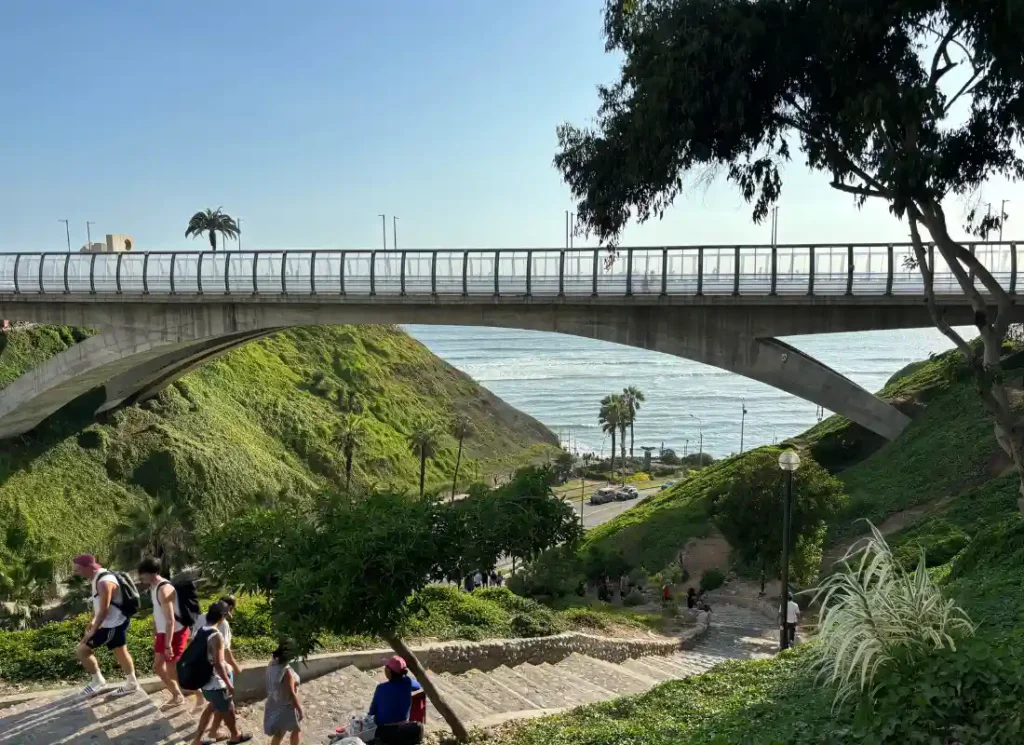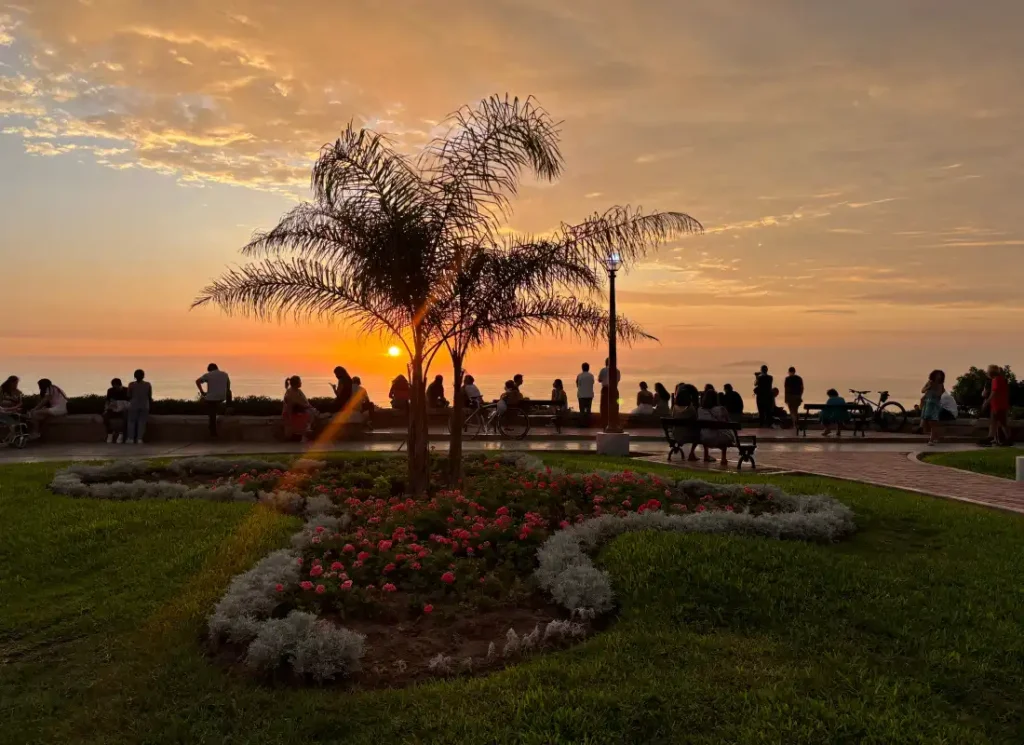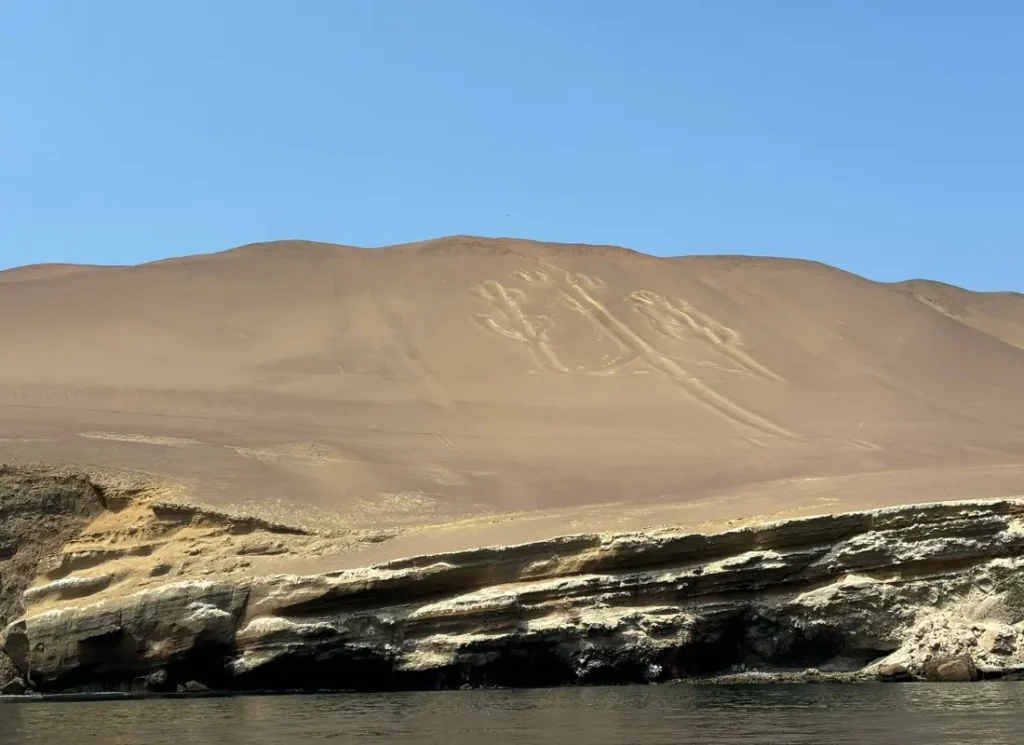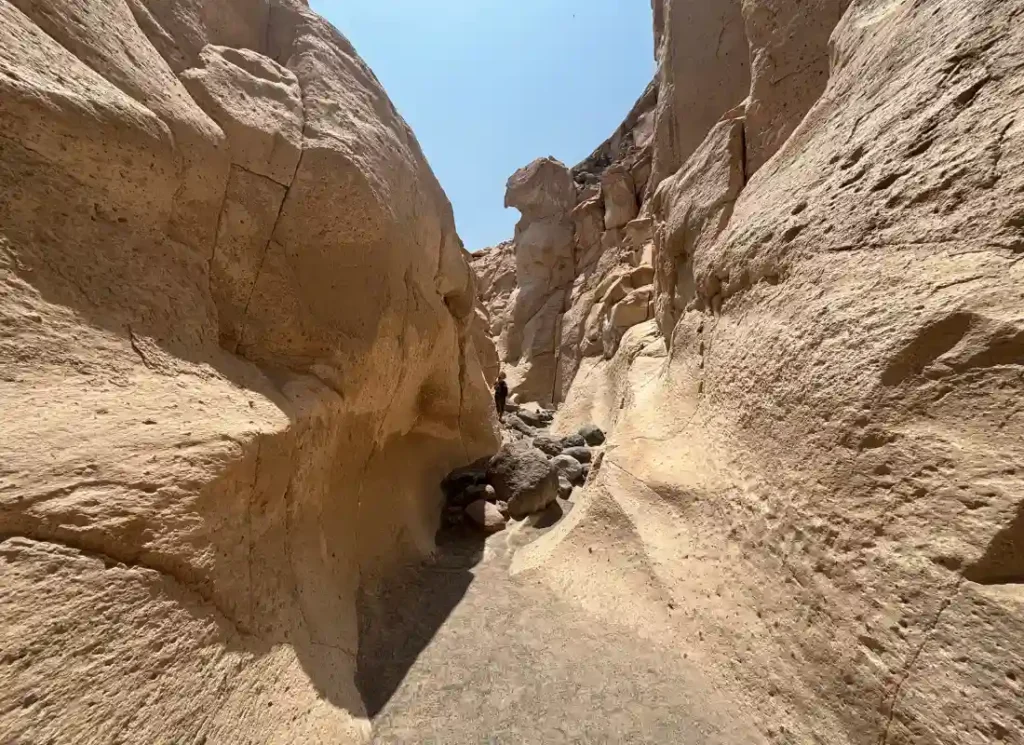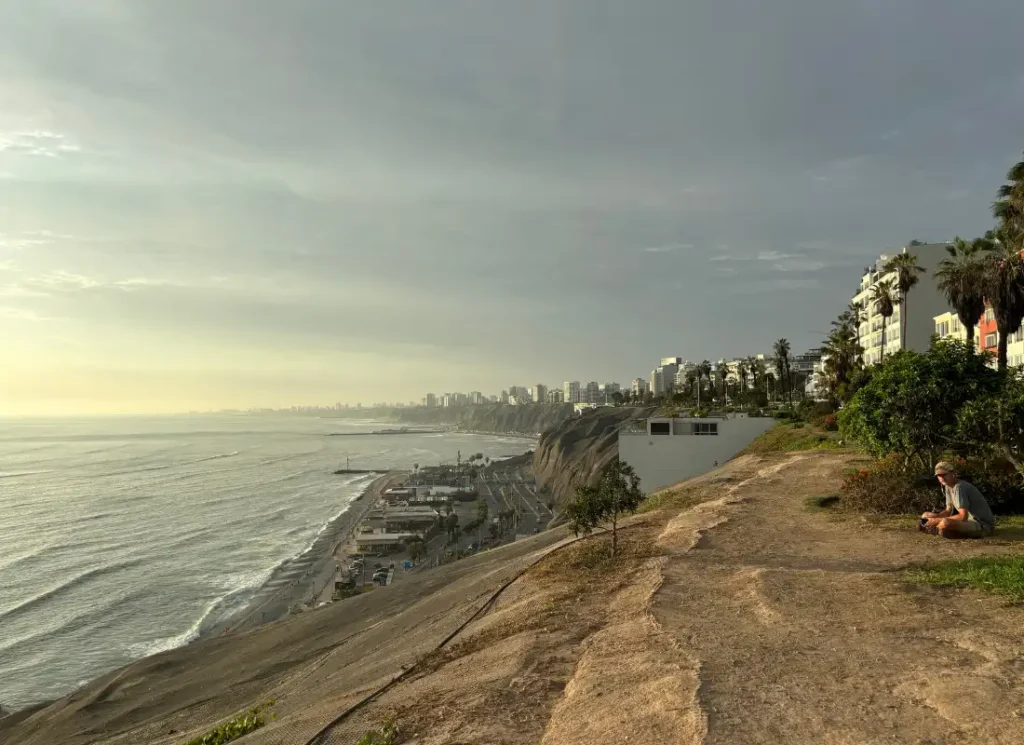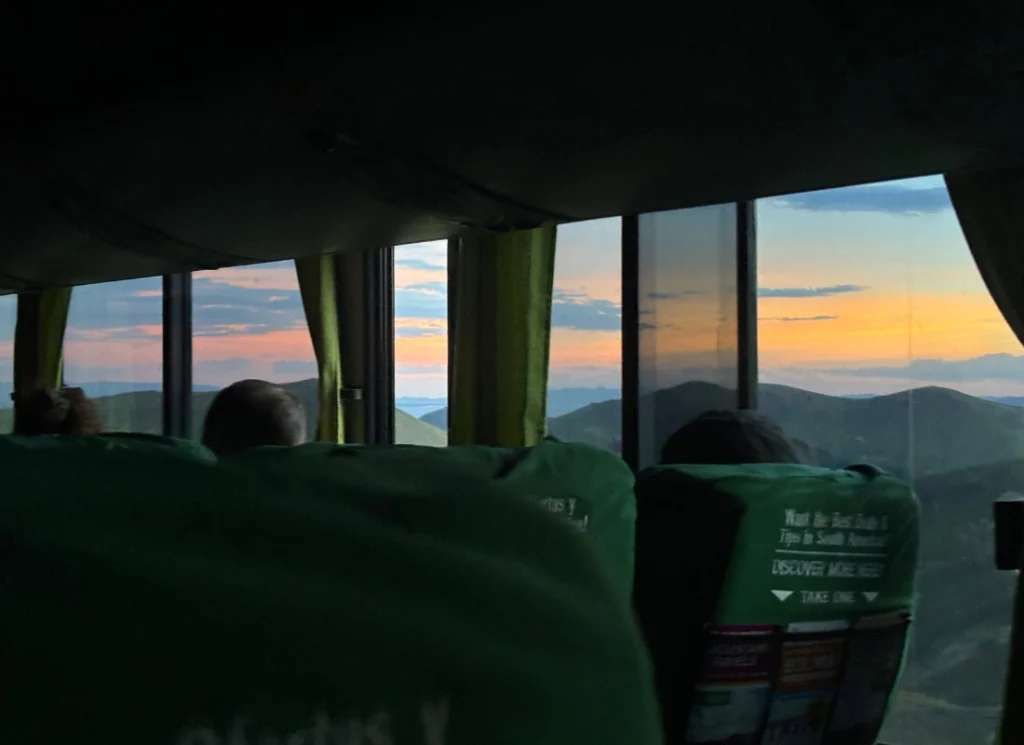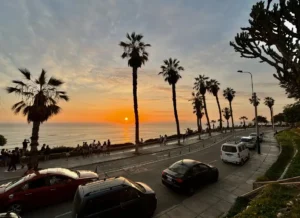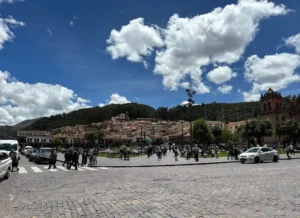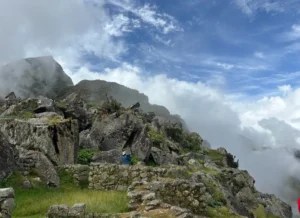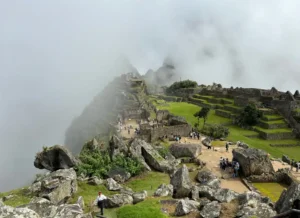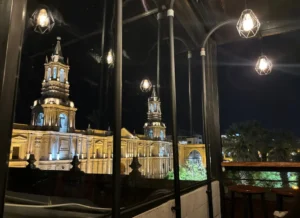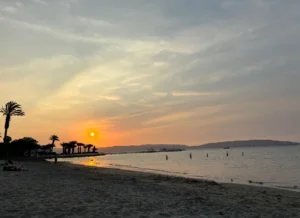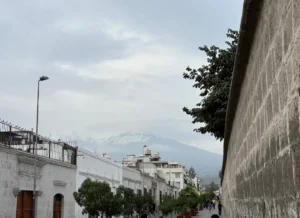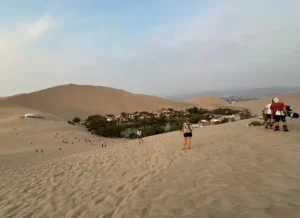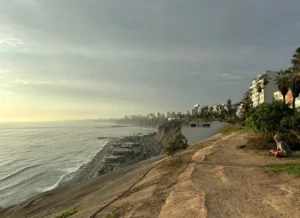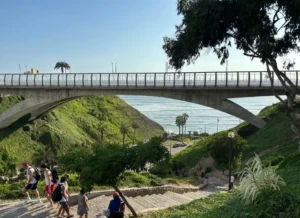Everything you need to know for your trip to Peru! What’s the best time to go, and where can you find vegetarian or vegan food? What is the currency in Peru, and do you need to protect yourself against mosquitos? And more questions answered about travelling in Peru, South America in this ultimate guide.
📍Geography & Places to Visit in Peru
Lima
Lima is the capital city of Peru, and is likely to be the first stop on your trip (you only need to read one of my Peru itineraries to find out why your first stop should not be Cusco! Lima is a bustling metropolis with a mix of very modern and colonial architecture, as well as a stunning coastline with some of the best sunsets I’ve ever seen, and incredible and unique graffiti. Most people will tell you to move on from Lima as soon as possible, which in some ways is true because there is so much more to see in Peru! But, if you have the time, I’d recommend spending a couple of days here. If you’re interested in food, get ready, because Lima is known as either the gastronomic capital of South America, or of the world, depending on who you ask.
🇵🇪 More on Peru: How to Get from Lima Airport to Miraflores
Huacachina
Huacachina is the only natural desert oasis in the whole of South America, and has become a popular destination amongst tourists thanks to its unique nightlife and proximity to the Peruvian desert, in which you can go sandboarding, sand-skiing, hiking or dune buggying. Or all of them! There are loads of things to do in Huacachina for its size, although I personally spent three days in Huacachina and this was more than enough.
🇵🇪 More on Peru: How to get from Huacachina to Cusco
Arequipa
Arequipa was one of my favourite places to visit when I was travelling in Peru. It’s known as the “White City” as most buildings are built from sillar, white volcanic rock, which is a pourus rock that helps the city to withstand earthquakes. It’s a great base for visiting many of Peru’s attractions like Colca Canyon, the salt lakes and rafting in the Chili River. As well as this, there are plenty of things to do in Arequipa itself, which makes it a great destination for spending a little longer in than many of the other stops on your Peru itinerary.
Cusco
Cusco is the ancient capital of the Incan Empire, and the cultural capital of Peru. I spent a few days here gathering supplies and acclimatising to the altitude before the Salkantay Trek. Whilst the city itself really is full of charm and culture, it is overwhelmed by tourists and, by extension, people trying to sell to those tourists. Whilst I really enjoyed Cusco in general, by the time I left for the Salkantay Trek, I was looking forward to escaping the constant bustle of sales people in the streets.
Machu Picchu
Machu Picchu, one of the seven wonders of the world and the last standing city of the Incan Empire, is an absolute must-see on your trip to Peru. It can be a hassle to book, but if you’re looking for an easy ride you can book an all-inclusive tour or day trip. Our Salkantay trek to Machu Picchu was completely full of drama, last minute changes and rushing to the finish line, but I wouldn’t have had it any other way. It only made the reward of arriving at Machu Picchu more exciting, and it was a moment from my trip that I will never forget.
The Amazon Rainforest
I didn’t go to the Amazon Rainforest whilst I was in Peru, other than the very edge of it that you hike through during the Salkantay Trek, but that doesn’t really count. The Amazon is quite far from the rest of the things to do in Peru, so you kind of have to design it as its own section of your trip. Most commonly, travellers would get a flight from the south of Peru to Iquitos, which is the largest city in the Peruvian Amazon and the best place to start your Amazon trip.
Lake Titicaca
Lake Titicaca is the highest navigable lake in the world, meaning the highest lake in the world that you can drive a large boat on. As well as marvelling. at the lake itself, there are several islands inhabited by indigenous people that you can visit and learn from, both on the Peruvian side and the Bolivian side, as the lake straddles the border between Peru and Bolivia. Generally Puno is the city in Peru that you would go to to visit Lake Titicaca. Whilst I have heard that Puno has a good nightlife, I personally didn’t get good vibes from the city nor the accommodation that I stayed in there, so I would only recommend staying here for one night as a way to access Lake Titicaca.
🇵🇪 More on Peru: An Honest Experience of Peru Hop Hop-On-Hop-Off Buses
🇵🇪 More on Peru: How to Plan the Perfect Peru Itinerary
🌎 Peru’s Borders
Peru shares borders with five countries: Ecuador, Colombia, Brazil, Bolivia, and Chile. Most of these borders are crossable, but some are more straightforward than others.
Always check the latest travel advisories and border situations before planning any border crossings, and remember to get your passport stamped!
Peru-Ecuador Border
I had originally planned to cross this border, as I was planning to do my entire trip through South America by land and/or sea. However, the universe had other plans for me when political tension inside Ecuador caused them to close their land borders whilst I was on my trip! Now, when I say “closed”, it’s not technically closed, but in order to cross you need to provide an original copy of a criminal record certificate for every country you’ve lived in for the last five years, translated into Spanish by a certified translator and legalised with the Hague Apostille. Now, not only would that cost you several hundred dollars, but you’d also have to then find somebody to take you across the border, because most of the buses are not running, of course, due to a lack of demand.
Peru-Colombia Border
There is only one way to cross this border, which technically involves going via Brazil (although you don’t generally stamp your passport, so technically it’s a Peru to Colombia crossing. You would fly from the south of Peru up to the Amazon, sail the Amazon River into Brazil, cross the border into Colombia, and then fly again into a more hospitable part of Colombia. So, possible, but not exactly an easy crossing! The rest of the border is swamped by the Amazon Rainforest and is uncrossable.
Peru-Brazil Border
Similar to the Peru-Colombia border, this border is entirely within the Amazon rainforest and not really used by tourists.
Peru-Bolivia Border
This border is one of the most commonly frequented by travellers, because so many people want to see Lake Titicaca and it is pretty accessible and easy to cross here. This is where I personally left Peru, and I actually did it with Peru Hop, an organised travel service that I did a full review on (just click that link!). I’d recommend both their service and crossing here on a public bus, which many of my friends did. It’s easy, safe, and a great way to experience everything that Lake Titicaca has to offer.
Peru-Chile Border
The Peru-Chile border is crossable and safe, however I haven’t done it myself. If you have the time to add it to your itinerary, I would absolutely recommend going via Bolivia as there are so many things to do there!
🌦 Weather in Peru & When to Go
Touristy Seasons in Peru
The highest season for tourism in Peru is from June to August, which coincides with the dry season in the Andes and the best time to visit Machu Picchu. However, this is also when it’s most crowded and expensive, and you should make sure to book tickets for anything well in advance. I personally went in March, right at the end of rainy season, and although it rained a lot in the Andes and Amazon on the Salkantay trek, the weather in other parts of Peru was still great. However, there were fewer tourists which made this an ideal time to go (except for the trek).
Rainy Season in Peru
The rainy season in the Andes and Amazon is from November to March. While it can make some activities challenging, it’s also when the landscapes are at their most lush and beautiful. I wouldn’t recommend doing any hikes during this season, which you’ll hear more about when I get around to writing about my experience with the weather and landslides on the Salkantay Trek…
Dry Season in Peru
The dry season runs from May to September. This is the best time for hiking and visiting Machu Picchu, but as I mentioned above, it’s also the busiest around this time.
Best Time to Visit Peru
I visited Peru in March, which, other than the hike, I found to be a great shoulder-season after most of the rain had gone but before the full tourist season came into swing. The crowds weren’t too bad, the weather was generally good, and prices were more reasonable. If you’re planning to hike, I’d recommend April-May or September-October to avoid both the rain and the high tourist season.
Sunrise & Sunset in Peru
There isn’t a huge difference in the sunrise and sunset times in Peru throughout the year, as the country is quite close to the equator. Sunrise is generally between 5:30 and 6:30 am, and sunset is usually between 6 and 6:30 pm, giving around 12 hours of daylight per day.
🚍 Getting Around & Public Transport in Peru
Buses
Long-distance buses are the most common and affordable way to travel around Peru. There aren’t many trains or airports, especially in southern Peru, so buses and overnight buses are usually the way to travel. Companies like Cruz del Sur and Oltursa offer really comfortable buses with reclining seats, onboard bathrooms, and often snacks, too. Even the regular seats are known to be the most comfortable of South America, but upgraded, more comfortable seats are also available for $5-10 extra.
I took several overnight and day buses in Peru, and found them to be really comfortable. The main problems you will encounter are winding roads and routes that take you up to high altitudes and back down again (but that’s where the snacks come in). I didn’t get sick or notice anyone around me getting sick on any bus rides in Peru.
Here are my guides to some popular routes:
🚌 Book your tickets with: BusBud
*Just so you know, we sometimes make a small commission on purchases made through some links on this website, at no extra cost to you.
Hop-On-Hop-Off and Private Transfers
The two companies I came across in Peru running hop-on-hop-off bus services in Peru were Wayki Bus and Peru Hop. Peru Hop is the most well-known and well-established, and all of their buses are completely private. Whereas I had some friends travelling with Wayki Bus who, on some legs of the journey, were simply given a taxi to the bus station and a ticket to the public bus (one, coincidentally, ended up on the same bus as me!). There’s still a lot of added value in this, what with the pre-booked taxi to the bus station and always having a point of contact if something goes wrong, but I thought I’d mention it anyway.
If you’re going to do a hop-on-hop-off service, I’d personally recommend Peru Hop.
Both of these bus services also offer private transfers for one leg of the journey if you don’t want to commit to a full experience with them. (This is how I was able to try out both companies as well as taking public buses.)
Flights
As I mentioned earlier, flying is the only reasonable way to get to or from the Amazon rainforest, no matter which country you come in from. You can also take cheap domestic flights between the biggest cities in Peru including Lima, Arequipa and Cusco, but smaller cities and towns like Ica, Huacachina and Puno don’t have accessible airports.
Taxis and Ride-sharing
Always use caution when ordering taxis in Peru. Especially around airports, there are a lot of scams. If you’re travelling to or from Lima Airport, follow this guide to taking the bus or ordering a private transfer – don’t rely on taxis in the airport or Uber. Anywhere else in Peru, Uber is fine, the only issue is that they are not allowed to collect from the airport.
Public Transport
Public transport around the city is generally safe, as long as you keep your valuables close and stick to routes that you know. When I was in Lima we took the public bus from Miraflores to Barranco, which felt completely fine and safe, but in other areas of Lima you should be careful. I wouldn’t personally take public transport after dark, especially not by myself, as Uber is quite affordable and much safer.
🍽 Food in Peru
Being Vegetarian or Vegan in Peru
While traditional Peruvian cuisine is heavy on meat and fish, you can find vegetarian and vegan options, especially in tourist areas and larger cities. I was a vegetarian the whole time I was travelling in Peru, and I didn’t come across many issues or places that I couldn’t eat. In Lima, Arequipa and Cusco, I found several great veggie-friendly restaurants, however, in smaller towns, you might need to be more creative and go a little off-menu.
Is Street Food Safe in Peru?
Yes, street food is safe in Peru, although it’s not as common as it is in other cities in South America. As always, make sure to look for stalls with high turnover (even if that means waiting in a queue) and only eat uncooked food (including fresh fruit and salad) if you can be absolutely certain it was washed with drinking water. Speaking of which…
Can You Drink Tap Water in Peru?
Generally, no, you cannot drink the tap water in Peru. I noticed when I was travelling in Central America that all of the accommodations I stayed in offered drinking water for free, but this was not the case in Peru; you have to buy it yourself, and some hostels sold it for extortionate prices! It’s always best to buy a large bottle at the supermarket, keep it at your hostel, and refill a smaller water bottle with it.
What Food Should I Try in Peru?
Peru is known for some pretty whacky cuisines, including guinea pig, llama burgers and alpaca meat. If you want to try them, the best places to try all three of these weird/wonderful dishes are in Arequipa or Cusco. (I know this by word of mouth, not by trying it myself, by the way.) Other must-try items on the menu are ceviche, which you must eat by the sea, Pisco sour cocktails, and lomo saltado.
🤟 Languages in Peru
What Languages Do They Speak in Peru?
Spanish is the official language and is spoken throughout Peru. However, in the Andean regions, including in the Sacred Valley, many people also speak Quechua, the language of the Incas. Indigenous languages are still spoken throughout the Amazon, too.
Do People Speak English in Peru?
English levels vary throughout Peru. Generally you can expect a good level of English from anyone within the tourism industry, including tour providers, hotel and hostel managers. Outside of that, English is less common and a few phrases of Spanish would be a good idea!
💵 Money & Currency in Peru
What is the currency in Peru?
The currency in Peru is the Peruvian Sol (PEN). At the time of writing, 1 USD is equivalent to about 3.7 PEN, but always check the current exchange rate before you pay for anything. It’s also quite common to pay for tours and transfers in USD (I had some real issues finding a place to draw dollars in cash to pay for the Salkantay Trek!), but everywhere else you will be asked to pay in Peruvian Soles.
How much does it cost to withdraw money in Peru?
ATMs are widely available in cities and towns. Most will charge a fee for international cards, typically around 15-20 PEN (about $4-5 USD), but there are some banks, including ScotiaBank and BCP that don’t charge for foreign withdrawals.
Do they take card in Peru?
A lot of places will take card in Peru, however it’s best not to count on it. I always made sure I had plenty of soles in cash wherever I went, in case the place didn’t accept card. Speaking of cards, I highly recommend Wise Bank to take travelling with you, as it was the only bank I didn’t have issues with when I was travelling in South America.
💵 Head over to: Wise Bank
⛑ Safety and Medical Care in Peru
Tourist Areas & the Tourist Trail
Peru is generally safe for tourists, especially if you stick to the well-trodden tourist trail in Peru. However, as with anywhere, it’s important to stay vigilant wherever you go, even if a town or city seems especially friendly. In larger cities like Lima, you should stick to the well-known touristy areas like Miraflores and Barranco – downtown is well known to be dangerous.
Pickpockets
Pickpockets can be an issue in Peru, just like they can be anywhere. Especially in crowded places like bars, markets and public transport, keep an eye on your belongings and use a money belt to keep your cash and anything else precious close to your body.
Violent Crime
Violent crime is usually not a problem on the tourist routes, but be aware that it can happen. Don’t walk alone at night, or trust anybody that you don’t know well. Off of the tourist route, such as in downtown Lima, you are at more risk of experience violent crime.
Taking a Local Guide
If you read this website a lot, you’ll know that I always recommend taking a local guide where possible, because they will always know something that you can’t read online, and you can give back to the local economy at the same time. Especially if you want to take some of the more adventurous hikes in Peru, it’s best to have a guide with you.
Altitude Sickness
If you’re heading to Cusco or other high-altitude areas, be prepared for potential altitude sickness. I talk a lot about this in my many Peru guides and itineraries – if at all possible, try to make the climb slowly and stop for a few days in a medium-altitude city, like Arequipa, before you head up to higher altitudes. If you experience altitude sickness, take it easy for the first day or two, stay hydrated, and consider taking medication like Diamox if you’re especially concerned.
Can you drink the tap water in Peru?
No, you generally cannot drink the tap water in Peru.
Travel Insurance & What to do if you get ill
Like on any trip, it’s absolutely essential to take full coverage health insurance, and make sure the health insurance company is covering you for all of the countries you’re visiting. On my trip in South America, I made an unexpected detour to Argentina and completely forgot until I arrived that my health insurance wouldn’t be valid there! Luckily nothing went wrong for me, but it’s best not to take the chance.
I’ve currently decided not to recommend a particular health insurance company, because I’ve never claimed on it myself therefore I can’t tell you if it’s any good or not.
Mosquitos
Dengue Fever
Unfortunately there is currently an outbreak of dengue fever across South America, and there is no current recommended preventative medication or vaccine. It’s especially important right now to wear protective clothing, sleep with a mosquito net if possible and, of course, use a good mosquito repellent. Air conditioning also helps to keep mosquitos away so stay in accommodation that has it if possible.
Yellow Fever & the Yellow Fever Vaccine
Yellow Fever is prevalent in some parts of Peru, particularly in the north and the Amazon region. If you’re planning to visit these areas, talk to a travel doctor about taking the vaccine before you go. Always use mosquito repellent and consider wearing long sleeves and pants, especially around dawn and dusk, as this is the most active time for the type of mosquito that transmits yellow fever.
Malaria
Malaria is only really a risk in the Amazon region of Peru. Again, make sure you wear mosquito repellent and talk to a travel doctor about preventative or curative medications before you go.
- 14 Things I Wish I Knew Before Travelling To Peru14 things I wish I had known (or things I’m glad I did know) before travelling in Peru this year!
- Peru | The Best Places and Areas to Stay in CuscoChoosing where to stay in Cusco is important; like every city, there are better areas, and more dangerous areas that should generally be avoided.
- What to Pack for the Salkantay Trek + Packing ListWhat to pack for the Salkantay Trek to Machu Picchu, based on my own experience of doing it this year.
- How Many Days to Spend in Machu Picchu, South AmericaHow many days to spend at Machu Picchu, Aguas Calientes and Cusco, accounting for altitude, things to do there, and hiking the Inca Trail or Salkantay Trek.
- What to Pack and What to Wear to Machu PicchuWhat to wear to Machu Picchu and what to pack for Machu Picchu, whether you’re going for a day trip or on a multi-day hike!
- How to Get from Arequipa to Cusco by Bus or PlaneThree ways to travel from Arequipa to Cusco by public bus, private transfer and by plane.
- Five Ways to Get from Huacachina to Cusco by Bus or PlaneFive ways to get from Huacachina to Cusco in Peru by bus and plane (although, there’s one I really don’t recommend!)
- The 12 Best Things to Do in ArequipaArequipa is a great place to pitch up for a few days, explore, and let yourself adjust to the new altitude… here are 12 great things to do while you’re there.
- An Ultimate Guide to the Peru Backpacking RouteA guide to the stops on Peru’s famous backpacking route, how to get between them, things to see and more tips and tricks for your trip to Peru.
- The Best Huacachina Tours, Activities, Day Trips 2024A list and my review of tours and day trips from Huacachina, Peru, having done them myself! From the Nazca Lines to sandboarding in the desert.
- Honest & Unpaid Experience & Review of Peru Hop BusesWhen I was travelling in South America this year, I did just about everything I could to try every different bus journey, activity and tour available so that I could come and tell you all about it. Of course, when I was in Peru, I couldn’t miss trying the hop-on-hop-off bus tickets by Peru Hop… Read more: Honest & Unpaid Experience & Review of Peru Hop Buses
- My 1 Week Peru Itinerary: 7 Days from Lima to CuscoPlan your 7 day itinerary in Peru based on my own trip this year, including: how to manage the altitude, important bus decisions and, of course, where to go!
- How to Plan the Perfect Peru Itinerary (Any Length)Everything you need to know to put together the perfect itinerary for your trip to Peru, no matter how much time you have.
- 24 Unmissable Famous Landmarks in PeruThis list of unmissable famous landmarks in Peru comes directly from the insanely long notes app on my phone, including both the sights I did and didn’t visit.
- 4 Ways to Get from Lima Airport to MirafloresThere are four ways to get from Lima Airport to Miraflores: by public bus, airport shuttle, taxi or private transfer. Whatever you do, don’t take an Uber!

